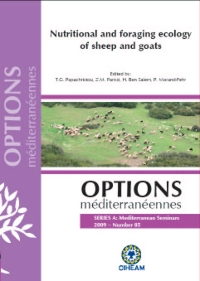| Article précédent | p. 165-169 | Article suivant |
Effects of shading on herbaceous plant patches transplanted reciprocally between three shading treatments
The effect of three shading origins and of three shading levels on the above-ground production and nutritive value of herbaceous vegetation were studied for two years. The experiment was conducted in Laggadia, north of the city of Thessaloniki, Greece close to the borders of the FYROM. Three treatments, 0% shading level (open grassland), 75% shading level (medium density forested area) and 95% shading level (high density forested area) were studied. From each origin 45 patches 30 × 30 cm were dug and then transplanted,15 patches to each treatment. The experimental layout was a split plot design. It included the three shading origins as the whole pots and the three shading treatments as sub-plots. Herbage production, CP and ADF contents were not affected by the shading origin, while NDF content was higher and ADL lower for the patches originating from the open area. Average herbage production and ADF content were statistically different between shading levels: they were higher for the open area compared to medium and high density forest stands. Only high shading resulted in significantly higher CP values on average, while NDF and ADL content was not affected by shading levels.
L'effet de trois types et niveaux d'ombrage sur la production de la biomasse aérienne et sur la valeur alimentaire de la végétation herbacée a été étudié pendant deux années. Cette expérience a été conduite à Laggadia, située au nord de Thessaloniki en Grèce à proximité des frontières de FYROM. Trois traitements, 0% d'ombrage (parcours ouvert), 75% d'ombrage (densité moyenne de la superficie forestière) et 95% d'ombrage (densité élevée de la superficie forestière) ont été comparés. Pour chaque origine, 45 morceaux de terre 30 × 30 cm ont été prélevés et transplantés (15 par traitement). Le modèle expérimental adopté est le split plot avec trois origines d'ombrage correspondant aux plots et trois niveaux d'ombrage représentant les sub-plots. L'origine de l'ombrage n'a pas affecté la biomasse produite et les teneurs en matières azotées totales (MAT) et en lignocellulose (ADF). En revanche, la teneur en NDF a été plus élevée et celle d'ADL plus faible pour les morceaux de terre provenant des parcours ouverts. La production moyenne d'herbe et la teneur en ADL ont varié significativement avec le niveau d'ombrage. En effet, ces deux paramètres ont été plus élevés avec les parcours ouverts par comparaison à la densité forestière moyenne et élevée. Seul l'ombrage le plus important a été associé avec des teneurs élevées en MAT, alors que les teneurs en NDF et ADL n'ont pas été affectées avec les différents niveaux d'ombrage.
- [ Afficher ]
- [ Télécharger ]
- [ Exporter la citation ]
Vous pouvez télécharger la citation au format :
- [ Imprimer ]
-
Mots-clés
AGROFORESTERIE, AZOTE, BIOMASSE, GRECE, LIGNOCELLULOSE, OMBRAGE, PLANTE, VALEUR NUTRITIVECiter cet article
Kyriazopoulos A.P., Nastis A.S. Effects of shading on herbaceous plant patches transplanted reciprocally between three shading treatments. In : Papachristou T.G. (ed.), Parissi Z.M. (ed.), Ben Salem H. (ed.), Morand-Fehr P. (ed.). Nutritional and foraging ecology of sheep and goats. Zaragoza : CIHEAM / FAO / NAGREF, 2009. p. 165-169. (Options Méditerranéennes : Série A. Séminaires Méditerranéens; n. 85). 12. Seminar on: Nutritional and Foraging Ecology of Sheep and Goats, 2007/10/11-13, Thessaloniki (Greece). http://om.ciheam.org/om/pdf/a85/00801002.pdf



